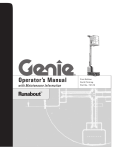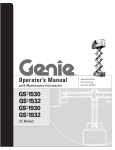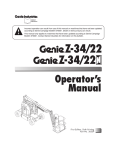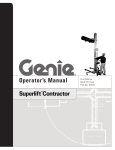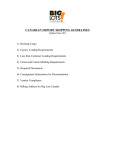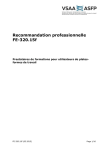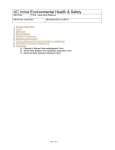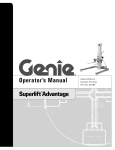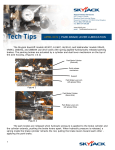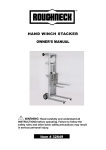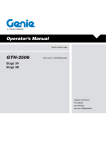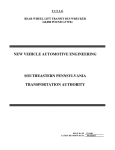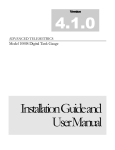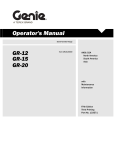Download Aerial Lift Manual - Forklift University, Inc.
Transcript
Forklift University Forklift training & certification for companies and individuals Operator Training Safety Manual Forklift University Aerial Lift Operator Training Guide Introduction Aerial Lift safety and fall prevention training is required by OSHA for any person that operates an aerial boom lift, scissor lift, aerial bucket truck or Man lift Basket on a Forklift. While this manual follows the OSHA guidelines and attempts to provide safe operating procedures and practices that operators can follow. It is imperative that every operator be familiar with the specific lift they will be operating by reviewing the safety manual included with the lift as well as company policies and OSHA Guidelines. The guidelines from OSHA are included with this manual, and should be used by operators to adhere to the proper safety standards. Review this manual and use it as a basis for safe operations. 2 www.ForkliftUniversity.com Forklift University Aerial Lift Operator Training Guide Table of Contents Accident Summaries.................................................................................................................................... 6 OSHA Requirements ............................................................................................................................... 14 Overviews.................................................................................................................................................. 20 General Regulations................................................................................................................................. 21 • An operator of aerial equipment is directly responsible for the safe operation of the lift at all times. 21 • An operator of aerial equipment is required to complete a pre-start inspection of the equipment and report any problems. ...............................................................................................................................21 • The supervisor is responsible for ensuring that these inspections are conducted...............................21 • An operator of aerial equipment shall ensure that all personnel on the platform are wearing appropriate safety gear for the work they will be performing....................................................................21 Many companies have special rules in addition to the OSHA guidelines, it is important to follow these rules as well as the OSHA rules when operating your lift. You can also find rules and instructions on operating your lift in the owner’s manual. Operator manuals are mandatory on each lift................................................20 Types of Aerial Platforms........................................................................................................................ 22 General Information ................................................................................................................................ 22 Load Capacity Ratings ............................................................................................................................ 24 The load capacity is the maximum allowable weight allowed in and spread evenly over the work platform. Keep in mind that the maximum allowable weight load includes you and your workmates, all your tools and materials you plan to use. ..................................................................................................................................24 Boomlift Load Ratings............................................................................................................................. 24 Safety Procedures..................................................................................................................................... 25 Basic Rules ........................................................................................................................................................25 Checking the Equipment ......................................................................................................................... 26 Before Operation...................................................................................................................................... 27 • Check the Work area. ..................................................................................................................................28 • Plan your work ............................................................................................................................................28 • Check overheads .........................................................................................................................................28 • Contact with energized power lines can cause DEATH or serious injury to persons in the platform and those on the ground in contact with or near the machine. .................................................................................29 Safe Distances from Energized Power Lines ......................................................................................... 29 Starting and Testing......................................................................................Error! Bookmark not defined. • • Look out for others......................................................................................................................................30 Mount Properly ...........................................................................................................................................30 Starting...................................................................................................................................................... 31 Test the Controls ...................................................................................................................................... 31 Operational Safety ................................................................................................................................... 32 • • Safe operating practices ..............................................................................................................................32 Raise and lower Safely................................................................................................................................33 Additional work safety............................................................................................................................. 34 Safe Shutdown .......................................................................................................................................... 34 3 www.ForkliftUniversity.com Forklift University Aerial Lift Operator Training Guide Safe Dismount........................................................................................................................................... 34 Fall Protection Overview......................................................................................................................... 35 Overview of the Fall Protection Standard ............................................................................................. 35 • Sets a uniform threshold height of 6 feet for providing consistent protection............................................35 • Prohibits the use of body belts as a part of personal fall arrest system as of Jan. ‘98 ................................35 • Prohibits the use of non-locking snap hooks in a personal fall arrest system and positioning system as of Jan. ’98. .............................................................................................................................................................35 Personal Fall Arrest Systems .................................................................................................................. 36 Requirements............................................................................................................................................ 36 • • • • • • • • • • Connectors must be: ....................................................................................................................................36 Dee-rings must: ...........................................................................................................................................36 Snap hooks must: ........................................................................................................................................36 Horizontal lifelines must: ............................................................................................................................37 Lanyards and vertical lifelines must: ..........................................................................................................37 Self-retracting lifelines and lanyards, when fully extended must be able to support: ................................37 Ropes and straps must:................................................................................................................................37 Anchorages must:........................................................................................................................................37 Full body harnesses: ....................................................................................................................................37 The attachment point:..................................................................................................................................37 General requirements for a personal fall arrest system ....................................................................... 38 • A personal fall arrest system must: .............................................................................................................38 While there are other types of fall prevention techniques outlined by OSHA, the ones discussed here directly relate to aerial lift and scissor lift operations. ...................................................................................................38 4 www.ForkliftUniversity.com Forklift University Aerial Lift Operator Training Guide UNSAFE PRACTICES CAUGHT ON FILM! 5 www.ForkliftUniversity.com Forklift University Aerial Lift Operator Training Guide Accident Summaries About 26 construction workers die each year from using aerial lifts. More than half of the deaths involve boom-supported lifts, such as bucket trucks and cherry pickers; most of the other deaths involve scissor lifts. Electrocutions, falls, and tipovers cause most of the deaths. Other causes include being caught between the lift bucket or guardrail and object (such as steel beams or joists) and being struck by falling objects. (A worker can also be catapulted out of a bucket, if the boom or bucket is struck by something.) Most of the workers killed are electrical workers, laborers, painters, ironworkers, or carpenters. INVESTIGATION SUMMARY On June 4, 2003, a 49 year-old male millwright employed at a magnetic powder manufacturing company sustained fatal injuries when an aerial work platform (an extensible articulating boom lift) he was operating tipped over. On the day of the incident, the victim and a co-worker operated the lift that was leased from a local leasing company to perform maintenance tasks. The aerial lift was equipped with a stabilizing device: an extendable axle to enhance the vehicle’s stability. The manufacturer stated in the Operators and Safety Manual that all operators must properly position the extendable axle and lock it into position before raising the platform or extending the boom. There were two safety features on the lift that were designed to ensure the use of the stabilizing device: an axle set indicator light and an interlock. A post incident test showed that while the indicator light worked, the interlock was inoperable. The plant maintenance crew did not receive the Operators and Safety Manual from the leasing company nor did they receive any training on how to operate the lift. According to the witnesses, the extendable axle was never set out during the entire day of the incident. At approximately 3:30PM, the victim was performing a visual inspection of the exterior of a bucket elevator that was about 70 feet high. He wore a harness with a lanyard that was attached and secured to the platform attachment point, a hard hat, safety glasses and steel-toed boots. Just prior to the incident, the co-worker saw the victim in the platform directly underneath the elevator’s catwalk that was about 54 feet high. 6 www.ForkliftUniversity.com Forklift University Aerial Lift Operator Training Guide A few minutes later, the co-worker and a swing shift millwright heard and saw the lift fall. The boom was extended to 38 feet when the lift tipped. The platform hit a pickup truck parked nearby causing the victim, who was still attached to the platform by the lanyard, to be bounced out of the platform. The co-worker and the swing shift millwright ran to the victim and found him unconscious and not breathing. The fire department and the rescue crew responded within three minutes after receiving a 911 call from the plant. The victim was transported to a local hospital where he was pronounced dead. New York State Fatality Assessment and Control Evaluation (NY FACE) investigators concluded that to help prevent similar incidents from occurring in the future, employers should: Ensure that the employees receive proper training before allowing them to operate aerial lifts; Require that the operators inspect the aerial lift and test critical safety features before each use and perform safety checkups each time the platform is repositioned during operation; Additionally, equipment-leasing companies should: Provide the customer who leases an aerial work platform with the manufacturer’s operating and safety manual; Inspect an aerial lift thoroughly prior to delivering it, and ensure that all safety features are operable at the time of delivery. INVESTIGATION SUMMARY On June 4, 2003, a 49 year-old male millwright employed by a magnetic powder manufacturing company sustained fatal injuries when an aerial work platform (an extensible articulating boom lift) he was operating tipped over. The New York State Fatality Assessment and Control Evaluation (NY FACE) investigators learned of the incident on June 5, 2003 from a news media report. On June 11, 2003, a NY FACE investigator traveled to the incident site to conduct a fatality evaluation. During the site visit, the NY FACE investigator met with the representatives of the magnetic powder manufacturing company, reviewed the company’s written safety and health programs and the employee training records, observed the preserved incident scene and the aerial work platform that was involved in the incident, and interviewed the witnesses. 7 www.ForkliftUniversity.com Forklift University Aerial Lift Operator Training Guide The case was reviewed with the Occupational Safety and Health Administration (OSHA) compliance officer who investigated the fatal incident. The manufacturer of the work platform provided technical information about the equipment. Police reports and the death certificate were reviewed. The victim’s employer had been in business since 1985 manufacturing magnetic powder used for making magnetic sheets for the advertising industry and magnets for the toy industry. At the time of the incident, the company employed 27 full time employees, among which were 13 production workers, three laboratory technicians, four (maintenance) millwrights, one janitor and six management personnel. The company had established a safety committee with eight members. The committee held monthly meetings and conducted annual safety inspections. All employees received orientation training at the time of hiring and annual refresher training on job safety and OSHA mandated subjects. The facility maintenance department was composed of a supervisor and three millwrights who were responsible for maintaining equipment and machinery in the plant. All maintenance workers received training on forklift safety and were certified by the company to operate forklifts. The maintenance department occasionally leased equipment such as an aerial work platform to perform annual and semiannual maintenance tasks. The victim’s employer did not provide specific training on how to safely operate the aerial lift nor did it purchase a training session from the leasing company. The victim had been employed by the company as a millwright for 13 years. The fatal incident was the first at the company. INVESTIGATION SUMMARY On June 3, 2003, the day before the incident, the maintenance department leased an 80-foot aerial lift from a local leasing company for maintenance work scheduled the next day. The lift was purchased by the leasing company at an auction 30 days before the fatal incident. The leasing company did not have any maintenance or inspection records for the lift. 8 www.ForkliftUniversity.com Forklift University Aerial Lift Operator Training Guide According to the owner of the leasing company, the owner performed a complete inspection of the lift after the purchase. However there was no written record of his inspection. It was the first lease of this lift. The lift was delivered to the plant on the evening before the incident. The manufacturer’s Operators and Safety Manual for this lift was not delivered with the lift. The plant maintenance crew did not receive any training from their employer or from the leasing company on safe operation of the lift. The aerial lift was manufactured in 1990. Its work platform capacity was 500 Lbs. and the hydraulic-operated extensible articulating boom could be extended to a maximum height of 80 feet. In order to increase the vehicle’s stability, the lift was equipped with an extendable axle - a stabilizing device that can expand the front steering wheel base from 80 inches to 120 inches. The manufacturer’s Operators and Safety Manual required that all operators properly position the extendable axle and lock it into position before raising the platform or extending the boom. The lift had two safety features that were designed to ensure the use of the stabilizing device: an axle set indicator (warning) light and an interlock. When the axle was not extended and locked, the warning light would illuminate; while the interlock would prohibit the boom to be extended more than 10 feet and raised above horizontal. According to the test performed after the incident, the axle warning light worked, but the interlock did not. A forensic examination of the inoperable interlock was performed and the result was not released by the representatives of the involved parties due to litigation at the time that this report was written. Figure 1. Bucket elevator that was being inspected by the victim during the fatal incident. 9 www.ForkliftUniversity.com Forklift University Aerial Lift Operator Training Guide On the day of the incident, the victim, a co-worker and the maintenance supervisor started working around 8:30AM. The main task of the day was to remove two pieces of fiberglass smokestack located approximately 60 feet above ground level. The maintenance crew had to remove the bolts that secured the stacks and prepare them to be picked up by a crane contractor in the afternoon. The victim and the co-worker both operated the lift in the morning and early afternoon without incident. According to the witnesses, the extendable axle was never set out during the entire day and the boom was fully extended while the two workers were both working in the platform at the same time near and around the smokestack. The victim and the co-worker wore harnesses with lanyards that were secured to the platform, hard hats, safety glasses and steel-toed boots. At approximately 3:30PM, the maintenance crew finished removing the fiberglass stacks. The supervisor and the victim discussed doing a visual inspection of the exterior of a bucket elevator (see Figure 1). The supervisor left after the discussion and the victim proceeded to perform the inspection. The bucket elevator was approximately 70 feet high and was used to transport iron oxide powder into the plant. The maintenance department inspected the elevator and looked for wear and rust spots approximately once every six months. The unpaved ground around the elevator was solid with grades less than 4 degrees (°). The manufacturer required that the platform should be leveled within 5°. The tires of the platform appeared properly inflated and had good treads based on the post-incident examination. Figure 2. The aerial work platform tipped over during the incident and hit a pickup truck that was parked near by. Just prior to the 3:45PM incident, the co-worker saw the victim in the platform directly underneath the elevator’s catwalk, 10 www.ForkliftUniversity.com Forklift University Aerial Lift Operator Training Guide approximately 54 feet high. A few minutes later the co-worker and a swing shift millwright who had just arrived at the plant heard and saw the lift falling (see Figure 2). According to the post-incident investigation, the boom was extended to 38 feet when the lift tipped. The platform hit a pickup truck parked nearby, resulting in the victim, who was still attached to the platform by the intact lanyard, being bounced out of the platform. The two millwrights ran to the victim and found him unconscious and not breathing. One of the millwrights ran back to the office to call 911 and the other turned the lift off and remained at the victim’s side. The fire department and the rescue crew responded within three minutes. The victim was transported to a local hospital where he was pronounced dead. CAUSE OF DEATH Cause of death was reported on the death certificate as fractured neck due to or as a consequence of multiple injuries. RECOMMENDATIONS Employers should ensure that their employees receive proper training and are qualified to operate an aerial work platform before allowing the employees to operate the equipment. Discussion: Prior to allowing an employee to operate an aerial lift, the employer should ensure that each operator receive training specific to that lift from a person who has the knowledge, training, and experience to train operators and evaluate their competence. The training should consist of formal instruction and hands-on training. Employers should certify that each operator has been trained and evaluated as required. Refresher training should be provided whenever there is an accident or near-miss incident, new assignment, or conditions change in the workplace. The employers can provide the training by themselves or they may choose to arrange for the training through a contract with the equipment supplier. 11 www.ForkliftUniversity.com Forklift University Aerial Lift Operator Training Guide The training should cover the following subjects: o Operating instructions, warnings, and precautions; o Locations and functions of controls and instrumentation; o Lift capacity; o Lift stability including meaning of axle set warning indicator light and use of interlock; o Any required lift inspection and maintenance; o Operating limitations; and o Other unique or potentially hazardous environmental conditions associated with each maintenance task that could affect the safe operation of the lift. In this case, the maintenance department leased aerial lifts only once or twice a year and the millwrights could not gain proficiency through daily operations. In addition, the millwrights may have to operate leased aerial lifts that differ in models and designs. It is extremely important that employers obtain the operation and safety manuals from leasing companies or equipment manufacturers, and require the operators to review the manuals and follow manufacturer’s instructions and requirements before each use. Employers should require that the operators inspect the aerial lift and test critical safety features before each use and perform safety checkups each time the platform is repositioned during operation. Employers should require that the operators examine and inspect an aerial lift before each use. o The pre-start inspection should include more than simply checking the fuel and oil supplies. A check of all components should be made to assure their security and proper functioning. A functional check of all systems, under no load, should be performed daily once the machine is ready for service from the ground control panel if possible. All critical safety features, such as interlocks, warning lights and alarms should be thoroughly tested. If the examination shows any condition adversely affecting the safety of the equipment, employers should not allow it to be placed in service. 12 www.ForkliftUniversity.com Forklift University Aerial Lift Operator Training Guide Each time when the aerial lift is repositioned during operation, the operators should ensure that the platform is operated on a surface within the limits specified by the manufacturer, and the outriggers, stabilizers, extendible axles, or other stability enhancing means, are used as required by the manufacturer. Employers should ensure that the operators follow the requirement through close supervision and work site inspection performed by a qualified person. Equipment leasing companies should provide the manufacturer’s operating and safety manuals to each customer who leases an aerial platform. Aerial platform leasing companies should provide manufacturer’s operating manual and safety manual to a leaseholder. These manuals are vital to communicate necessary safety information to users and operators. Leasing companies should always inspect safety features on an aerial platform to ensure that it is in working order before the equipment is released for delivery to a customer. o Aerial platforms should be inspected, serviced and adjusted to manufacturer’s requirements prior to each lease. The critical safety features should be tested. All malfunctions or problems identified Riverside, Calif., July 2007 A drywall contractor, who was not an authorized user, jumped on a scissor lift one weekend on a Southern California jobsite. While he was running the machine, it became unstable. Another co-worker attempted to stabilize the machine with a telehandler but to no avail. As the machine fell, the scissor lift operator was able to grab an overhead water line and hold onto it long enough to be rescued. No one was injured in the incident. - Reader Submission Enlarge Image Lift and Access Reader Submission 13 www.ForkliftUniversity.com Forklift University Aerial Lift Operator Training Guide OSHA Requirements 14 www.ForkliftUniversity.com Forklift University Aerial Lift Operator Training Guide 15 www.ForkliftUniversity.com Forklift University Aerial Lift Operator Training Guide 16 www.ForkliftUniversity.com Forklift University Aerial Lift Operator Training Guide 17 www.ForkliftUniversity.com Forklift University Aerial Lift Operator Training Guide 18 www.ForkliftUniversity.com Forklift University Aerial Lift Operator Training Guide For the complete OSHA guidelines on forklift safety you can go to www.ForkliftUniversity.com or www.OSHA.gov. 19 www.ForkliftUniversity.com Forklift University Aerial Lift Operator Training Guide Overviews Aerial operations require the operator to always be aware of their environment, company rules, and the mechanical state of their machines. When policies and safe procedures are not followed, or equipment is not maintained properly and regularly accidents happen. This guide is an overview of safe operating procedures, rules and guidelines for aerial operators. In this Chapter we review your company specific policies, and some general information about aerial lifts. Company or Site Policies Many companies have special rules in addition to the OSHA guidelines, it is important to follow these rules as well as the OSHA rules when operating your lift. You can also find rules and instructions on operating your lift in the owner’s manual. Operator manuals are mandatory on each lift. Your first day on the job, you should clarify your company policies with your supervisor. List site or equipment policies below: 1. _____________________________________________________ _____________________________________________________ 2. _____________________________________________________ _____________________________________________________ 3. _____________________________________________________ _____________________________________________________ 4. _____________________________________________________ _____________________________________________________ 5. _____________________________________________________ _____________________________________________________ Additional notes: ___________________________________________________________________ ___________________________________________________________________ 20 www.ForkliftUniversity.com Forklift University Aerial Lift Operator Training Guide General Regulations An operator of aerial equipment is directly responsible for the safe operation of the lift at all times. An operator of aerial equipment is required to complete a pre-start inspection of the equipment and report any problems. The supervisor is responsible for ensuring that these inspections are conducted. An operator of aerial equipment shall ensure that all personnel on the platform are wearing appropriate safety gear for the work they will be performing. A full body harness is required for fall protection and a body belt is never allowed for fall protection on any type of lift. While OSHA allows for operators to not utilize the full body harness when on a scissor lift (based on the scaffolding guidelines) as long as the operator stays within the area of the railings, some companies still require this type of fall prevention over and above OSHA guidelines. Ulitmately, You must follow your companies guidelines. 21 www.ForkliftUniversity.com Forklift University Aerial Lift Operator Training Guide Types of Aerial Platforms You should be trained on the specific type of industrial equipment you will be using. There are 3 basic types of aerial platforms: Manual vertical aerial platforms Powered aerial platforms Boom-supported aerial platforms Common names include: Boomlifts, Manlifts Articulated booms, Aerial lifts Aerial platforms Cherry pickers. Scissor lifts General Information 22 www.ForkliftUniversity.com Forklift University Aerial Lift Operator Training Guide Maximum working height vs. Maximum platform height Maximum platform height is the height from the bottom of the platform measure to the ground when the aerial work platform is fully raised. Maximum work height is the height measured from the top of the operators’ head to the ground when the aerial platform is raised. Wheel base widths You should be aware of the wheel base width of the unit you will be operating. If your width is too wide you may have difficulty getting into tight areas. If your wheelbase is to narrow you may have stability issues. Small boom lift type aerial work platforms start with a 5-foot wheelbase (and scissor / vertical lifts with a 30 inch wheelbase) width and the largest aerial work platforms are equipped with a 10-foot wheelbase. Unit Weight Scissor lifts are typically 6000lbs while a 40foot boom lift can weigh up to 26,000 lbs. 23 www.ForkliftUniversity.com Forklift University Aerial Lift Operator Training Guide Load Capacity Ratings Since all aerial work platforms carry people and materials, they are rated with a maximum lift load capacity. The load capacity is the maximum allowable weight allowed in and spread evenly over the work platform. Keep in mind that the maximum allowable weight load includes you and your workmates, all your tools and materials you plan to use. As long as you are within the unrestricted load capacity limits are operating the lift on level ground that will support the units weight, and are employing any necessary safety devices you can operate the lift at any height or extension safely. The rated workload capacity decals will always be located at each entrance into the platform and the operator control stations. You should always verify that these decals are in place during your pre-shift inspection. Boomlift Load Ratings Boomlifts are slightly different form the basic scissor/vertical lift. A boomlift is basically a lever, which uses 2 wheels as a fulcrum. A fulcrum is the point or support on which a lever turns. The weight of the unit load, on the side of 2 wheels, is counterbalanced against overturning by dead weight of the boomlift on the other side of the 2 wheels. If this counterbalance capacity is exceeded, the lift overturns. Therefore, the capacity rating of a boomlift is a specific load carried at a specific distance from the fulcrum wheels and spread evenly over the operator platform. This is called the boom lift’s “load capacity”. All boomlifts, because they are designed to carry people, have a maximum “unrestricted load capacity”. 24 www.ForkliftUniversity.com Forklift University Aerial Lift Operator Training Guide Safety Procedures Basic Rules Check the work area for hazards that might cause a tip-over Maintain specified distances from electric power lines and apparatus. Keep everyone clear of a working platform. Never allow ground personnel near your machine and NEVER permit anyone to stand or pass under a raised platform. Make certain everyone is clear of the machine before you begin lowering the platform Wear approved fall protection devices as required by your machine Never modify or remove any part of the equipment unless authorized by the manufacturer If machine is to be unattended, lower the platform and shut off the power. Engage the parking break and take steps to prevent unauthorized access. Use all available protective safety devices: Chain, gate or bar closures Safety bars Stabilizers or outriggers Extended axles Turntable lock Interlock devices Ground controls Audible and visual alarms Know what devices are required on your machine and never remove or modify any of them. 25 www.ForkliftUniversity.com Forklift University Aerial Lift Operator Training Guide Before you begin using the lift Checking the Equipment Check for missing, damaged or unreadable signs Check for broken, missing, damaged or loose parts Check pivot pins for damage Check tires for cuts, bulges and pressure levels Check for cracked welds and other evidence of structural damage Check hydraulic system for leaks or damage Check outriggers, stabilizers and extend axles Check upper and lower control stations Check platform guardrails and gates. 26 www.ForkliftUniversity.com Forklift University Aerial Lift Operator Training Guide Aerial Platform Lift Pre-start Inspection form The pre-start inspection shall be performed prior to each day’s or shift’s use of the aerial platform lift by an authorized and trained user of the lift. Documentation of the inspection shall be maintained by each department, with a copy of the most recent inspection document stored on the lift. Check off the items that have been inspected or mark the N/A box if the item does not apply to the lift being inspected. Place any comments in the space provided below. If there are any of these items that are not satisfactory place the lift out of service until the item is corrected. Department lift belongs to: Make of lift: Model of lift: Serial #: Inspector’s Name Item Inspected Date of Inspection Okay Not Okay N/A Operating controls Emergency controls Safety devices Personal protective devices Pneumatic system (leaks) Hydraulic system (leaks) Fuel system (leaks) Cables Wiring harness Loose/missing parts (locking pins/bolts…) Tires and wheels Placards and Warnings Operational Manual Outriggers/Stabilizers Guardrail system and locking gate Other items Comments: Inspector’s Signature Date 27 www.ForkliftUniversity.com Forklift University Aerial Lift Operator Training Guide Before You Begin Operations Check the Work area. o Check the ground, or floor level o Inspect the area you will travel for holes, debris, obstacles, ropeoffs, or rough spots. o Look for oil spills, wet spots, slippery surfaces, soft soil, and standing water. Plan your work o Make sure you know how you will approach the overhead work area and where you will place your machine for proper lift clearance. o If the aerial platform is to be operated in an area where the boom or platform lifts may cross the path of a motion or overhead bridge crane, lock out the controls for the bridge crane or take precautions to prevent a potential collision. Check overheads o Check the clearances of overhead and doorways and canopies. Take notice of any obstructions. Know exactly how much clearance you have around electric power lines. 28 www.ForkliftUniversity.com Forklift University Aerial Lift Operator Training Guide Contact with energized power lines can cause DEATH or serious injury to persons in the platform and those on the ground in contact with or near the machine. Safe Distances from Energized Power Lines Normal voltage Minimum Required Clearance KV (phase to phase) To 300V Over 300V to 50KV Over 50KV to 200KV Over 200KV to 350KV Over 350KV to 500KV Over 500KV to 750KV Over 750KV to 1000KV 29 Avoid Contact 10 feet 15 feet 20 feet 25 feet 35 feet 45 feet www.ForkliftUniversity.com Forklift University Aerial Lift Operator Training Guide Look out for others o Before starting, walk completely around the machine. Make sure no one is under it, on it or close to it. Let other workers and bystanders know you are starting up and don’t start until everyone is clear of the machine. Mount Properly Use 3 points of contact Face the machine when you enter or leave the machine Clean shoes and wipe your hands before climbing on. Use handrails, ladders or steps as provided when mounting Never use control levers as hand holds Never step on foot controls when mounting or climbing off Never Attempt to mount or dismount a moving machine Never walk or climb the elevating assembly to gain access Make sure all handrails, toe boards, and gates are in place and secure before raising o Enter or exit from the ground only. o o o o o o o o o 30 www.ForkliftUniversity.com Forklift University Aerial Lift Operator Training Guide Starting o Check all instruments, gauges, and indicators o Follow manufacturers’ instructions for use of starting fluids. o Don’t carry loose cans of starting fluid on the machine while operating. o When starting in an enclosed space make sure there is enough ventilation. o Do not start or drive the machine into a confined area such as refineries where flammable gasses may be present. Test the Controls o After start, re-check gauges and lights o Check audible and visual alarms. o Check all control functions including emergency stop and upper control station. o Move slowly until you are certain everything is operating properly. If anything is not working properly or a control does not respond properly do not use the machine! 31 www.ForkliftUniversity.com Forklift University Aerial Lift Operator Training Guide Operational Safety Safe operating practices o o o o o o o o o o o o o o o o o o o Know the rated work load of your machine and never exceed it Before raising the platform disperse the load evenly. Make sure nothing interferes with any of the controls. Do not carry materials on railings unless approved for that purpose. Do not at any time add a load that exceeds the rated capacity. Know your attachments functions and keep additional clearance requirements in mind. If there is more than one person on the platform, only the designated operator should operate the controls Operate the controls smoothly Avoid sudden stops, turns, starts or changes in direction. Never use the controls except from the operators station Never leave the platform without returning to the ground, unless it is an elevated entrance and the manufacturer approves the exit. If the platform is to be left unattended, lower the platform, shut off the engine, engage brake, and take steps to prevent unauthorized use. Never override any hydraulic, mechanical or electrical safety device. Watch out for others; keep everyone clear of a working platform. Never drive an aerial platform up to someone standing in front of a fixed object. Never move or position any part of the machine over anyone. Travel Safely Always wear personal fall-protection devices Travel only in the full down, stowed position when possible. 32 www.ForkliftUniversity.com Forklift University Aerial Lift Operator Training Guide o Pay attention to overheads in your path. o On a boom-type machine, do not use the drive to maneuver in close to an obstacle. Place your machine and then use the swing and boom functions to get in close. Raise and lower Safely o Make sure the machine is on firm level ground before raising the platform. o If equipped, make sure extendible axles, outriggers, or stabilizers are fully deployed. o You may require blocks with extenders, be sure the blocks can support the rated weight. o Check clearance around the unit, above and blow before raising, lowering or rotating the unit. o If platform or any part of the machine becomes entangled with an adjacent structure, do not attempt to free machine by operating platform controls. CALL FOR ASSISTANCE! o Never attach wire, cable or similar items to the platform. Should they tangle or catch your machine could tip over. 33 www.ForkliftUniversity.com Forklift University Aerial Lift Operator Training Guide Additional work safety Never use ladders, planks, steps or other devices to provide additional reach Never lean over or sit on the platform railing. Keep both feet on the platform floor at all times. Never belt off an adjacent structure when working on an aerial platform. Never use the structure of the platform as a welding ground Safe Shutdown Travel to a suitable parking area Place platform in a stowed position Come to a full stop Place controls in neutral Idle engine for gradual cooling Shut off engine or electrical power Take steps to prevent unauthorized use. Safe Dismount Never dismount from a moving machine Use 3 points of contact Watch for slippery steps and be aware of controls Never Jump from or off the machine. 34 www.ForkliftUniversity.com Forklift University Aerial Lift Operator Training Guide Fall Protection Overview Fall protection consists of several components since most aerial lift operators only utilize one or two, we will discuss these in detail. However, the complete list of fall protection systems is: Guardrail Systems Safety Net Systems Personal Fall arrest Systems Positioning Device Systems Warning Line Systems Controlled Access Zones Safety Monitoring systems Covers Protection from Falling Objects Fall Protection Plan Overview of the Fall Protection Standard Sets a uniform threshold height of 6 feet for providing consistent protection. Prohibits the use of body belts as a part of personal fall arrest system as of Jan. ‘98 Prohibits the use of non-locking snap hooks in a personal fall arrest system and positioning system as of Jan. ’98. Offers employers flexibility to choose from various options to provide fall protection. Provides sample fall protection plans that can be modified for sitespecific conditions. 35 www.ForkliftUniversity.com Forklift University Aerial Lift Operator Training Guide Personal Fall Arrest Systems A personal fall arrest system means a system used to arrest an employee in a fall from a working level. It consists of an anchorage, connectors, a body harness and may include a lanyard, deceleration device, lifeline, or suitable combinations of these. A body belt cannot be used for fall arrest. Requirements Connectors must be: o Drop forged, pressed or formed steel or a comparable material o Corrosion-resistant with smooth edges to prevent damage to other parts of the system Dee-rings must: o Have a minimum tensile strength of 5000 pounds o Be tested to a minimum tensile load of 3600 pounds without cracking, breaking or changing shape. Snap hooks must: Have a minimum tensile strength of 5000 pounds Be tested to a minimum tensile load of 3600 pounds without cracking, breaking or changing shape. Be of the locking type or compatible in size to other pieces they connect with. o Unless locking –type snap hooks are used, the non-locking type cannot be hooked: To each other To a webbing, rope or wire To a Dee-ring or other snap hook or connector attached To a horizontal lifeline To any object of a different size or shape 36 www.ForkliftUniversity.com Forklift University Aerial Lift Operator Training Guide Horizontal lifelines must: o Be connected to devices that lock in both directions. o Be designed, installed and used under the supervision of qualified persons. Lanyards and vertical lifelines must: o Have a minimum breaking strength of 5000 pounds o Be attached to each worker separately o Be protected against cuts and abrasions. Self-retracting lifelines and lanyards, when fully extended must be able to support: o A minimum tensile load of 3000 pounds, if they automatically limit free-fall distance to 2 feet. o A minimum tensile load of 5000 pounds, if they do not limit free fall to 2 feet. Ropes and straps must: o Be made from synthetic fibers. Anchorages must: o Be free of other anchorages that support or suspend platforms o Support at least 5000 pounds per attached worker, or they must be designed, installed and used in a personal fall arrest system that maintains a safety factor of at least 2 and is under the supervision of a qualified person. Full body harnesses: o Must be used only as a part of a personal fall arrest system. o The attachment point for a harness must be in the center of the back near shoulder level or above the head. Units with an attachment in the front are used only for positioning not fall protection. 37 www.ForkliftUniversity.com Forklift University Aerial Lift Operator Training Guide General requirements for a personal fall arrest system Employers must properly rescue a working in the event of a fall or make sure that the workers can raise themselves. A personal fall arrest system must: o Limit the maximum force to 1800 pounds when using a full body harness. o Be rigged so that you cannot fall more than 6 feet, or come in contact with a lower level and are brought to a complete stop with a minimum deceleration distance of 3 ½ feet. o Withstand 2 times the potential impact of a worker free-falling 6 feet, or the free-fall distance allowed by the system, whichever is less. o Be removed from service if used to prevent a fall o Be inspected before each use or if subject to impact. o Not to be attached to guardrail systems or hoists o Be in use at a hoist area and must be rigged so that you can only travel to the edge of the work surface. While there are other types of fall prevention techniques outlined by OSHA, the ones discussed here directly relate to aerial lift and scissor lift operations. 38 www.ForkliftUniversity.com Forklift University Aerial Lift Operator Training Guide Operator Performance Evaluation: Aerial Lift Operator: _____________________________ Date: _____________ Instructor: _______________________ Location: ___________________ Satisfactory Needs Improvement Follows Pre-Operation Inspection Safe Start Up Clear the area of bystanders Wear hearing protection, as necessary Dress appropriately Determine if powerline precautions are required Vehicle is positioned on level ground Set the parking brake Chock the wheels Engage power supply Set the outriggers Make sure vehicle is stable before entering bucket/platform and raising and lowering the platform. Follow additional procedures in operator’s manual Safe Manuevering Doesn’t endanger people or property Operates equipment according to manufacturer’s instructions Avoid jerking controls Avoid obstacles Avoid potential crush points Safe Shut-down Slowly lower boom to rest on supports Secure the boom according to operator’s manual Raise the outriggers Shut off power supply Depress parking brake Remove outrigger pads (if applicable) and wheel chocks Follow additional procedure in operator’s manual 39 www.ForkliftUniversity.com Forklift University Aerial Lift Operator Training Guide Operating Manual Acknowledgement Form By signing this document I am certifying that I have received a copy of the operations manual for the aerial platform lift shown below. Upon training and authorization by my department, I am expected to operate this lift. I understand that it is my responsibility to review and understand the safe operation of this aerial platform lift based on the training I receive and the manufacturer’s recommendations. I understand that if, at any time, I have any questions regarding the information found in the user’s manual I can contact Risk Management and Safety, my supervisor or the manufacturer to obtain my answers. Name (print) Department User/Operator’s name (sign) Date 40 www.ForkliftUniversity.com Forklift University Aerial Lift Operator Training Guide Arizona: 602-903-1895 California: 909-740-3647 Nevada: 702-765-0239 Texas: 512-351-4611 Kansas: 785-307-9683 41 www.ForkliftUniversity.com









































